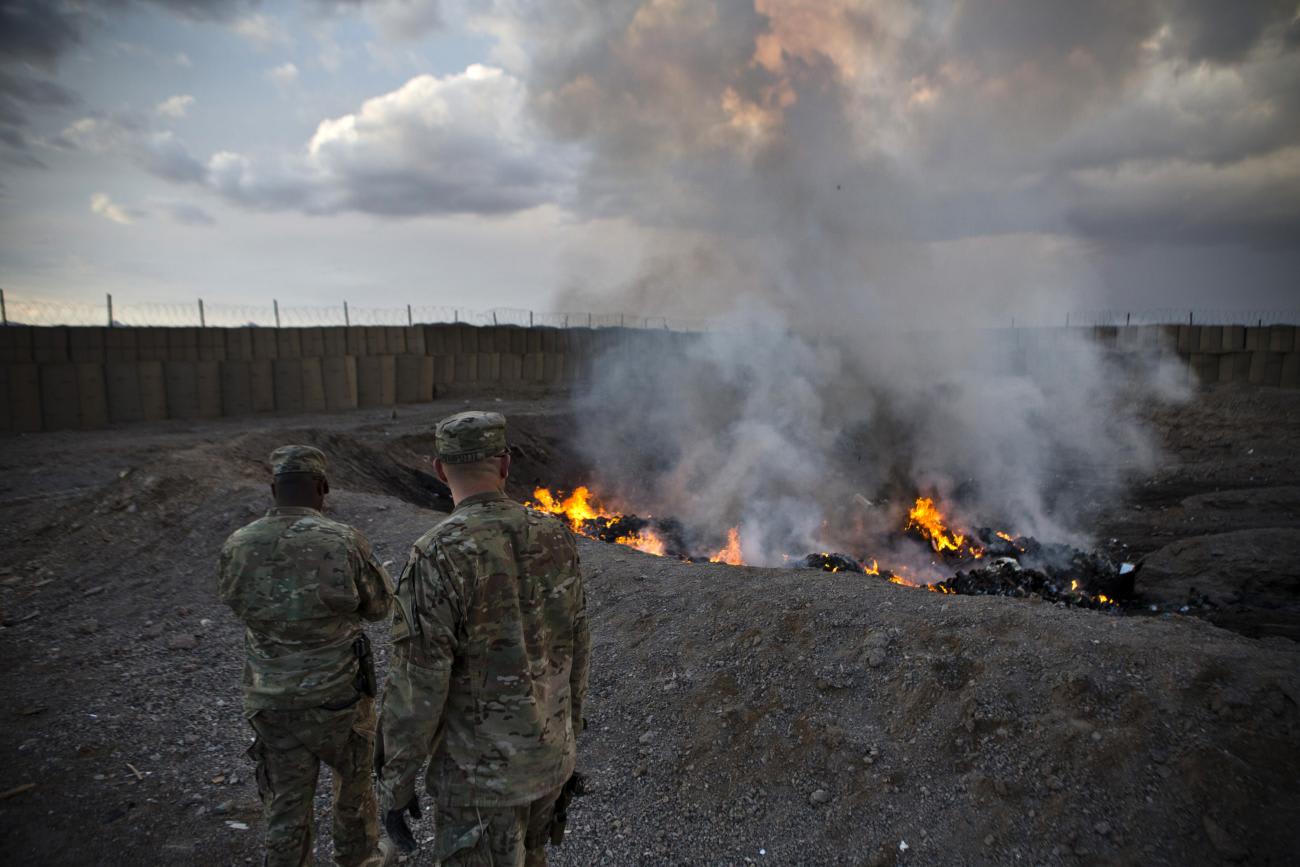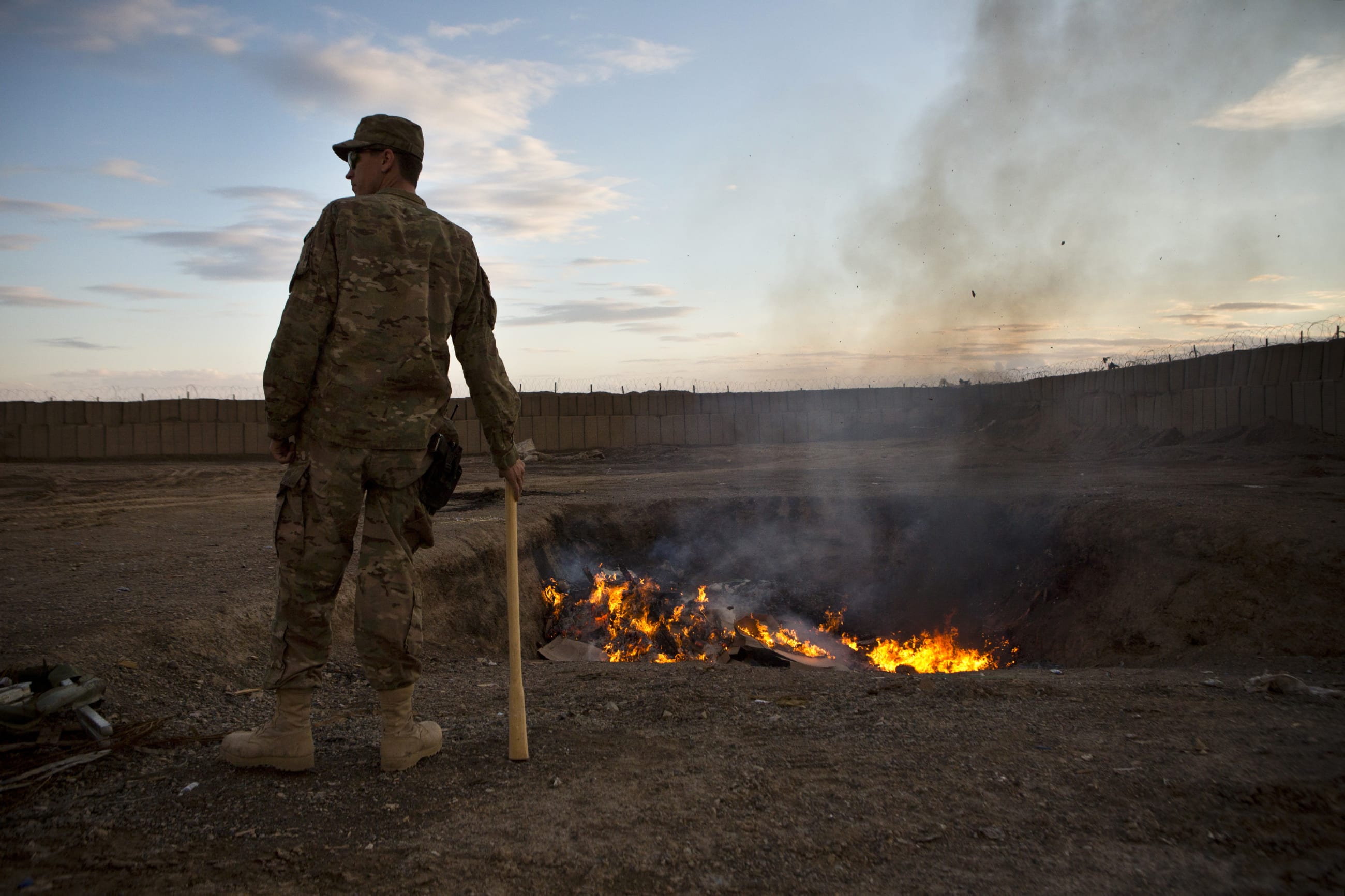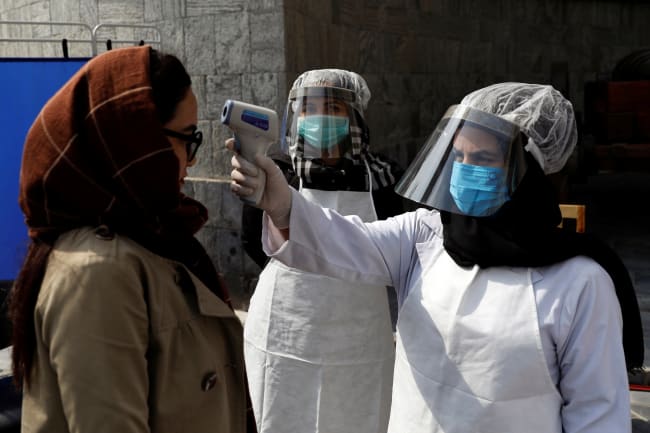If the U.S. military were a country, it would be among the top fifty emitters, polluting more than Morocco, Peru, and Sweden combined. Burn pits, open-air areas designated to burn waste, are a significant part of this pollution, releasing chemical toxins from garbage into the atmosphere, which can lead to adverse health effects for humans and the environment. Waste management is critical to preventing the disposal of harmful toxins, protecting the health of deployed soldiers, and safeguarding nearby populations. The United States should invest more money in the adoption of waste-to-energy (WTE) technology to reduce the health and environmental consequences of waste disposal at military bases, especially at nonpermanent bases.
Department of Defense (DOD) policy states that burn pits can only be used on military bases when no other options for waste management are available. This is especially prominent for nonpermanent bases in conflict zones because they are often considered short-term missions with limited resources. According to a U.S. Government Accountability Office report, burn pits were the most common form of waste disposal during the U.S. involvement in Iraq and Afghanistan. The report recommended a shift toward incinerators and recycling programs in 2010, but implementation has been slow given low funding allocations, limited recycling facilities in the host countries, and the prioritization of security developments. Although the number of burn pits decreased in Iraq after 2010, they increased in distribution to more than 250 operational sites across the country.
If the U.S. military were a country, it would be among the top fifty emitters, polluting more than Morocco, Peru, and Sweden combined.
The costs associated with burn pits are enormous. In 2022, Congress passed the PACT Act, a bipartisan effort to extend health benefits to veterans, soldiers, and their families who face health complications such as brain cancer, lung cancer, and asthma due to contact with burn pits. Within the first seven months of PACT's adoption, 360,000 veterans applied for benefits. Budgetary allocations for the act from 2022 to 2031 are $277 billion, but with currently proposed appropriations, mandatory spending for the same period could increase to $667 billion.
Developments in WTE technology provide a potential alternative to burn pits. Waste-to-energy technology is the process of extracting energy from the disposal of waste and has been deployed as a solution for greener waste removal of municipal solid waste. WTE captures methane that is burned from waste in incinerators by converting heat to steam in a process called combined heat and power (CHP) technology and then transporting it to a turbine to generate electricity. This process can produce electricity and decrease waste volume by around 87 percent.
Critics of WTE cite the economic costs associated with its implementation, and they are not wrong. Converting waste burning into viable energy sources requires incinerators and training. The cost of U.S. facilities is higher than in other countries, and limited government funding for research and development for WTE projects holds the United States back. Other countries present an example to emulate. Sweden started building WTE infrastructure in 1969 but began prioritizing it in 1990 as a new method of waste management. Today, WTE plants convert approximately 50 percent of household waste to energy thanks to decades of budgetary allocations, helping reduce waste in landfills to just 1 percent of the country's generated trash.

Research and development prove integral to reducing the startup costs involved for WTE. Debates on how WTE should be implemented are not new to DOD. A 2011 report suggested the technology was too complex for the military to implement. However, a 2017 study by Strategic Environmental Research and Development Program, the Pentagon's environmental science and technology program, recommended new technological developments for WTE implementation in both small and large military bases. Their findings recommended that technologies lower operational costs to adapt WTE and reduce personnel and waste production. This is reflected in DOE programs, and the department announced a new plan to expand research for biofuel development and WTE technologies in 2020, totaling $97 million.
Although a step in the right direction, government plans need to be targeted when it comes to appropriating funding for WTE-related research. For instance, one improvement would be increasing research into CHP processes, which increase the flexibility of WTE by increasing its adaptability to colder environments by converting heat energy from the incineration process while minimizing effects on rising temperatures. By increasing the prioritization and speed at which research is adopted by the government, WTE integration can be both efficient and beneficial.
In the past, the DOD has poorly and inefficiently implemented incinerator facilities. This was in part due to reliance on external contractors for waste management on military bases, which increased the projects' completion times. Ultimately, design errors and inconsistent oversight of their adoption significantly hampered the DOD's ability to build incinerators in Afghanistan and Iraq, two contingency operations. The primary cost for WTE is in building incinerators; 23 new structures in Afghanistan in 2010 cost more than $81 million. The government needs to be more proactive in enforcing government contracts to build incinerators, especially because most American WTE facilities are privately owned.
The average U.S. soldier in Iraq and Afghanistan produced an estimated ten pounds of solid waste per day.
WTE technology needs to be built into military bases from the initial plans. For instance, waste management policies should find a place in base agreements with host countries. Further, personnel on military bases should be trained on environmental standards and practices. From the example in Sweden, integrating waste infrastructure, like sorting waste in residential buildings, led to more social acceptance of WTE policies. Similarly, emphasizing training for personnel and soldiers on military bases would increase practical prioritization of waste management execution during base activity itself.
The average U.S. soldier in Iraq and Afghanistan produced an estimated ten pounds of solid waste per day on contingency bases in Iraq and Afghanistan, more than twice the amount generated by the average American. Adopting WTE technology would also improve relations with countries that host U.S. military bases, which have expressed concerns about environmental degradation associated with bases. Recycling developments, including programs to achieve zero-waste goals, should be developed in parallel to WTE, which offers opportunities for increased energy efficiency and independence consistent with the U.S. national defense strategy's shift to include environmental concerns as security priorities. Although implementation is costly, the adverse effects of burn pits, especially health concerns for military personnel, should increase the urgency for implementing WTE. Given rising climate concerns in conflicts and U.S. security interests, waste management threatens to impede the efficiency of U.S. military missions. WTE provides a proactive solution to improving waste management on military bases abroad.

AUTHOR'S NOTE: The author would like to thank Elsabet Jones, Alexandra Labonte, and Rachel George, from CFR's Education Department, for their contributions to this post.












